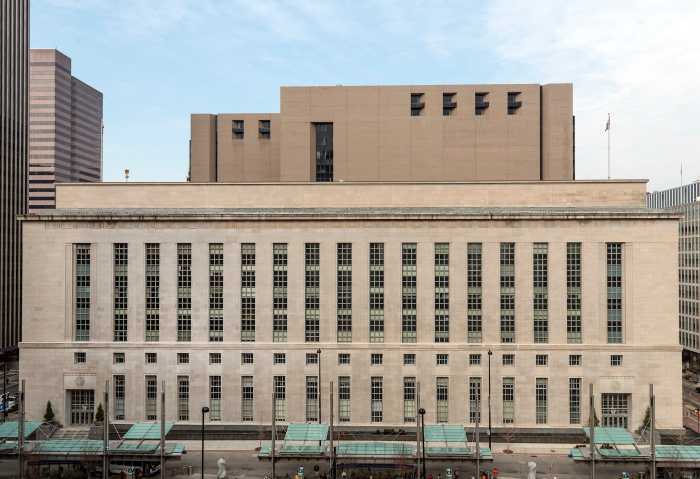
Long Time Resident Renee Levine Speaking at Public Hearing (Photo: Meghan Sackman)
April 25, 2019 By Meghan Sackman
About 300 people showed up for a tense public hearing at Queens Borough Hall last night to hear the Mayor’s Office present its case as to why a 1,437-inmate prison should be located in Kew Gardens.
The hearing, a marathon affair that lasted nearly four hours, was a significant step for the city as it takes its plan to the public as part of the ULURP process. The city needs the site to be rezoned and a street de-mapped in order for the jail to be built.
The evening began with a presentation by the Mayor’s Office of Criminal Justice and Department of Corrections that drew jeers from an emotional crowd. Many interrupted the presentation, protesting that the project was a done deal even before the public process began.
Representatives of the City shrugged off these complaints and walked the crowd through the plan that many had heard before.

Kew Gardens Jail Rendering (Presentation from the Mayor’s Office)
Dana Kaplan of the mayor’s Office of Criminal Justice said the city plans to close Rikers Island and replace it with four borough-based jails by 2027. Currently, New York City has 11 jails, eight of which are on Rikers Island.
The city said it was its moral imperative to close the Rikers facilities, since they are inaccessible and have a history of inmate violence and mistreatment.
“The facilities themselves [on Rikers Island] are in a state that we don’t believe is emblematic of the types of reform goals that we have for our criminal justice system,” Kaplan said.
The city aims to reduce the prison population down from 8,000 to 5,000 by 2027 and house the inmates in four jails–each with 1,437 inmates.
The city then unveiled the rendering of the Kew Gardens facility that will go up where the Queens Detention Center is currently located and the adjacent municipal parking lot. The facility will be 270 feet tall, the equivalent of a 26-story apartment building.
The dilapidated detention center–that once housed 500 inmates–will be demolished.
A new public parking lot will be built containing 676 spaces, along with 605 below grade accessory parking spaces.

The new facility was presented as being “more dignified” than Rikers–offering a large visiting area, more recreational space for inmates and additional community space. The jail will also have more natural light than Rikers.
The jail will have smaller housing units. Kaplan said the smaller units will help with security, protecting inmates from violence.
The Kew Gardens facility will also house the city’s entire female inmate population. Currently there are about 400 to 500 female inmates in the system, a number the City believes can be reduced to 200. The city also plans for a maternity ward and a nursery to be built at the jail.
Many attendees were not swayed by the city’s presentation. “Do it on Rikers!” some people shouted, arguing that the new ‘humane’ jails should be built there.
Several Community Board 9 members were handed the microphone after the city’s presentation and had some harsh words about the plan.
Some argued that the plan was too costly, citing figures that it could cost between $10 billion and $30 billion to build the four jails. Others argued that the overarching plan–which involves variables such as reducing the inmate population–was incomplete and too theoretical.
“There is no plan. What they’ve certified is a concept,” said Co-Chair of the Land Use Committee, Sylvia Hack. “We consider this, some of us, as a fiscally insane proposal.”

Land Use Committee Co Chair Sylvia Hack at Public Hearing (Photo: Meghan Sackman)
Hack complained that the jail plan was hatched before the community was consulted and that the billions of dollars would be better spent on fixing the homeless crisis.
“This kind of money should be spent on making sure that people get their education, can afford housing, so they don’t wind up being incarcerated,” Hack said.
About 40 to 50 people testified at the hearing and were very forthcoming with their views. Not all were opposed.
Several members of the Close Rikers Build Communities group testified that they were in favor of the plan, arguing that Rikers needs to be shut down permanently. Many shared their own experiences of being detained at Rikers.
They argued that the borough-based jails make the Department of Corrections more accountable, since the jails are not out of sight and forgotten like on Rikers.
“The reason people knew about [the loss of heat in the Brooklyn jail] is because we could walk by and see the lights off, we could walk by and hear the people in need, screaming and banging on their cells,” said a member of the Close Riker’s group that identified herself as Miss V.
“That is because it was in our borough. If it’s not we will not know about it,” she said, also referring to the high number of sexual assault that has come from Rikers.
Some speakers called on the city to scrap its borough-based jail plan and close Rikers. They were part of the advocacy group No New Jails, which aims to reduce the inmate population to such a level that such facilities are not needed.
Members of this group chanted “If they build it, they will fill it,” implying that the city and law enforcement will feel pressure to fill the empty cells with more prisoners, if they are built.
But there were many people who just hated the concept of a jail being in their neighborhood.
Residents testified that their security would be at risk; that it would create traffic congestion; and a large shadow would loom from the building that would blanket the surrounding neighborhood.
Judge Greg Lasak, a candidate in the Queens District Attorney race, said there is no need for a jail that big in a residential community, especially one built on such an expedited timeline. He said that Rikers Island’s facilities should just be improved with the misconduct towards detainees being corrected.
“There should be no jail built here in Kew Gardens. We don’t need to build a jail here especially the size that is anticipated,” Lasak said.
“What is the push here? If there’s such a push here why don’t we go to Rikers island with shovels, and start building a brand new facility on Rikers Island? But we do have to deal with the violence on Rikers island.”
Community Board 9 is required to vote on the plan by June 3. It’s vote is advisory.
The plan will then be reviewed by Queens Borough President Melinda Katz. She has 30 days to hold a public hearing and make a non-binding recommendation.
The City Planning Commission will then have 60 days to host a public hearing, make some modifications and vote on the plan. The City Council will then have 50 days to review and vote. Should it pass the council, the plan will go into effect.

No New Jails Group Protesting at Public hearing (Photo: Meghan Sackman)

































